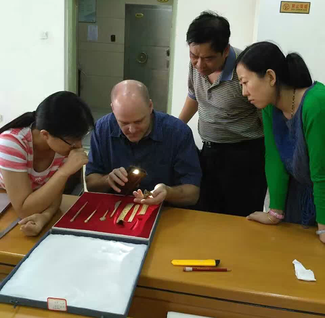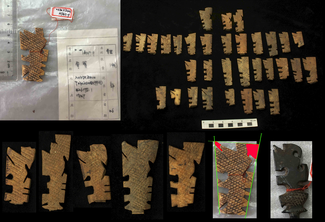Chinese Bronze Age Economy Project
This article first appeared in ISAW Newsletter 16, Fall 2016.
Rod Campbell
Assistant Professor of East Asian Archaeology and History
 ISAW Graduate Student Zhang Yan and Rod Campbell at the Anyang municipal museum examining bone artefacts in their collection. Photo courtesy of Rod Campbell.
The work continued this summer on the long-term, multi-site Chinese Bronze Age Economy Project - this time with the generous support of the New York University Research Challenge Fund. While most of the summer was spent in Zhengzhou, continuing to analyze the animal bones recovered from the only well-excavated Shang dynasty village site, ISAW professor Rod Campbell and ISAW PhD student Zhang Yan also visited the Shang regional center of Daxingzhuang in Shandong province to look for evidence of specialist bone working. As a result, a new collaboration with Shandong University was brokered for a full study of Daxingzhuang worked bone, bringing the three most important Anyang period (ca. 1250-1050 BCE) Shang sites into the ambit of our investigation: Anyang, the 3000 ha capital; Daxingzhuang, a 30 ha regional center; and Guandimiao, the remote 2 ha village.
ISAW Graduate Student Zhang Yan and Rod Campbell at the Anyang municipal museum examining bone artefacts in their collection. Photo courtesy of Rod Campbell.
The work continued this summer on the long-term, multi-site Chinese Bronze Age Economy Project - this time with the generous support of the New York University Research Challenge Fund. While most of the summer was spent in Zhengzhou, continuing to analyze the animal bones recovered from the only well-excavated Shang dynasty village site, ISAW professor Rod Campbell and ISAW PhD student Zhang Yan also visited the Shang regional center of Daxingzhuang in Shandong province to look for evidence of specialist bone working. As a result, a new collaboration with Shandong University was brokered for a full study of Daxingzhuang worked bone, bringing the three most important Anyang period (ca. 1250-1050 BCE) Shang sites into the ambit of our investigation: Anyang, the 3000 ha capital; Daxingzhuang, a 30 ha regional center; and Guandimiao, the remote 2 ha village.
 A composite slide comparing Anyang decorated pin heads to pins recovered from a site in Shandong province (where Rod Campbell’s team went to investigate the possibility of connections between Anyang bone working and other Shang centres). Photo courtesy of Rod Campbell.
Despite their disparate natures and the hundreds of kilometers that separate them, they appear to be linked in the distribution of bone hairpins that the team is increasingly certain were mass-produced solely in Anyang. It appears that not only did the royal capital possess precociously large and well-organized workshops dedicated to the large-scale production of quotidian bone artifacts, but the products of these workshops were distributed to remote villages and regional centers alike. Our preliminary study at the regional center of Daxingzhuang, moreover, makes us increasingly certain that while minor bone working may have occurred locally, it is clearly distinguishable from the products of the Anyang workshops. If these preliminary conclusions turn out to be correct, we will be forced to confront the realization that the ancient Chinese economy was far more precocious and integrated than anyone has dared imagine and that its history will need to be re-written.
A composite slide comparing Anyang decorated pin heads to pins recovered from a site in Shandong province (where Rod Campbell’s team went to investigate the possibility of connections between Anyang bone working and other Shang centres). Photo courtesy of Rod Campbell.
Despite their disparate natures and the hundreds of kilometers that separate them, they appear to be linked in the distribution of bone hairpins that the team is increasingly certain were mass-produced solely in Anyang. It appears that not only did the royal capital possess precociously large and well-organized workshops dedicated to the large-scale production of quotidian bone artifacts, but the products of these workshops were distributed to remote villages and regional centers alike. Our preliminary study at the regional center of Daxingzhuang, moreover, makes us increasingly certain that while minor bone working may have occurred locally, it is clearly distinguishable from the products of the Anyang workshops. If these preliminary conclusions turn out to be correct, we will be forced to confront the realization that the ancient Chinese economy was far more precocious and integrated than anyone has dared imagine and that its history will need to be re-written.